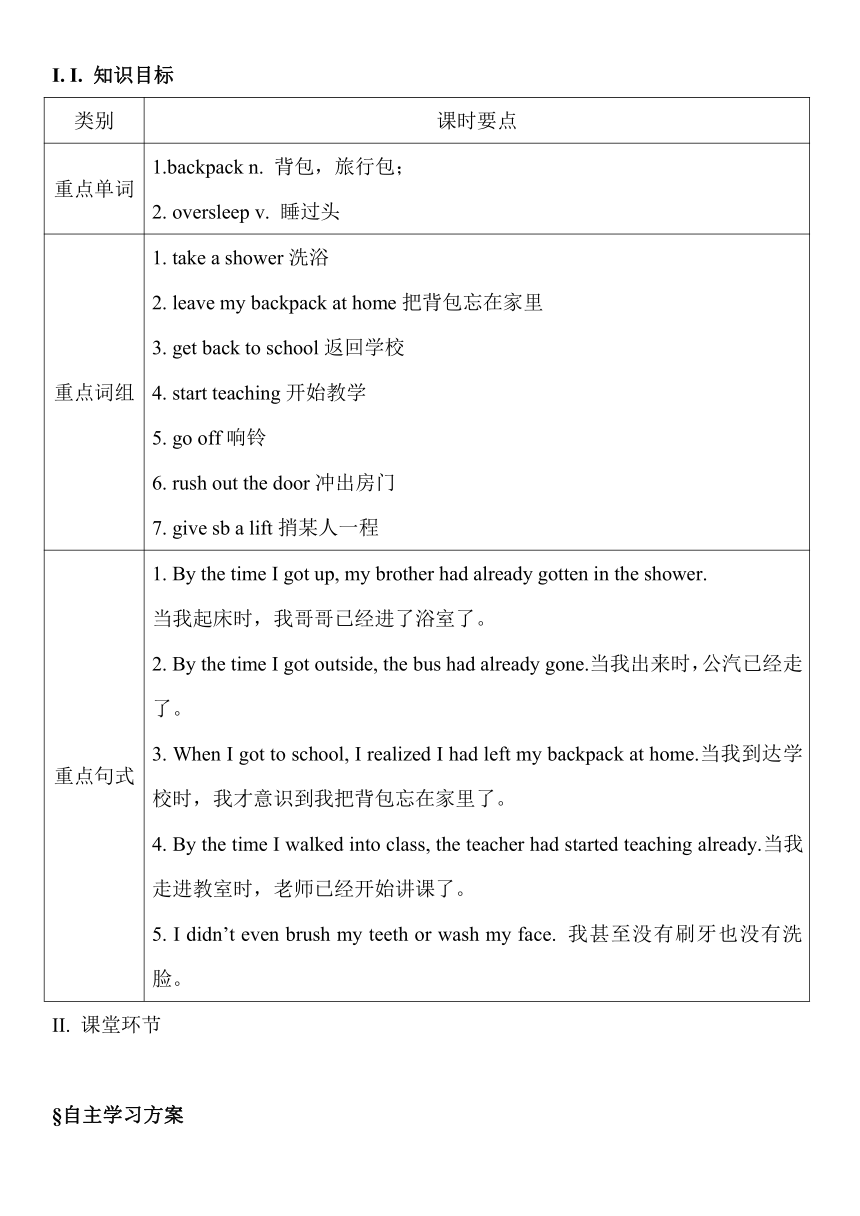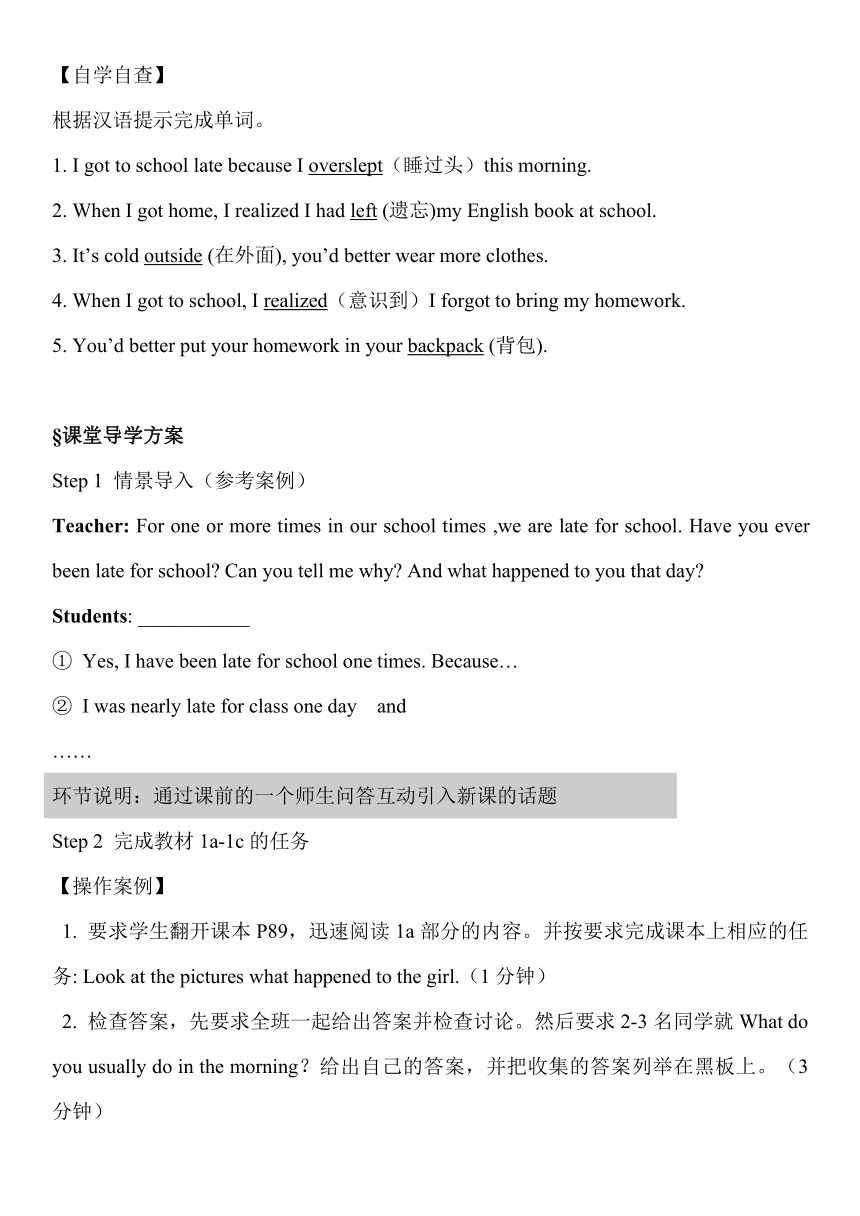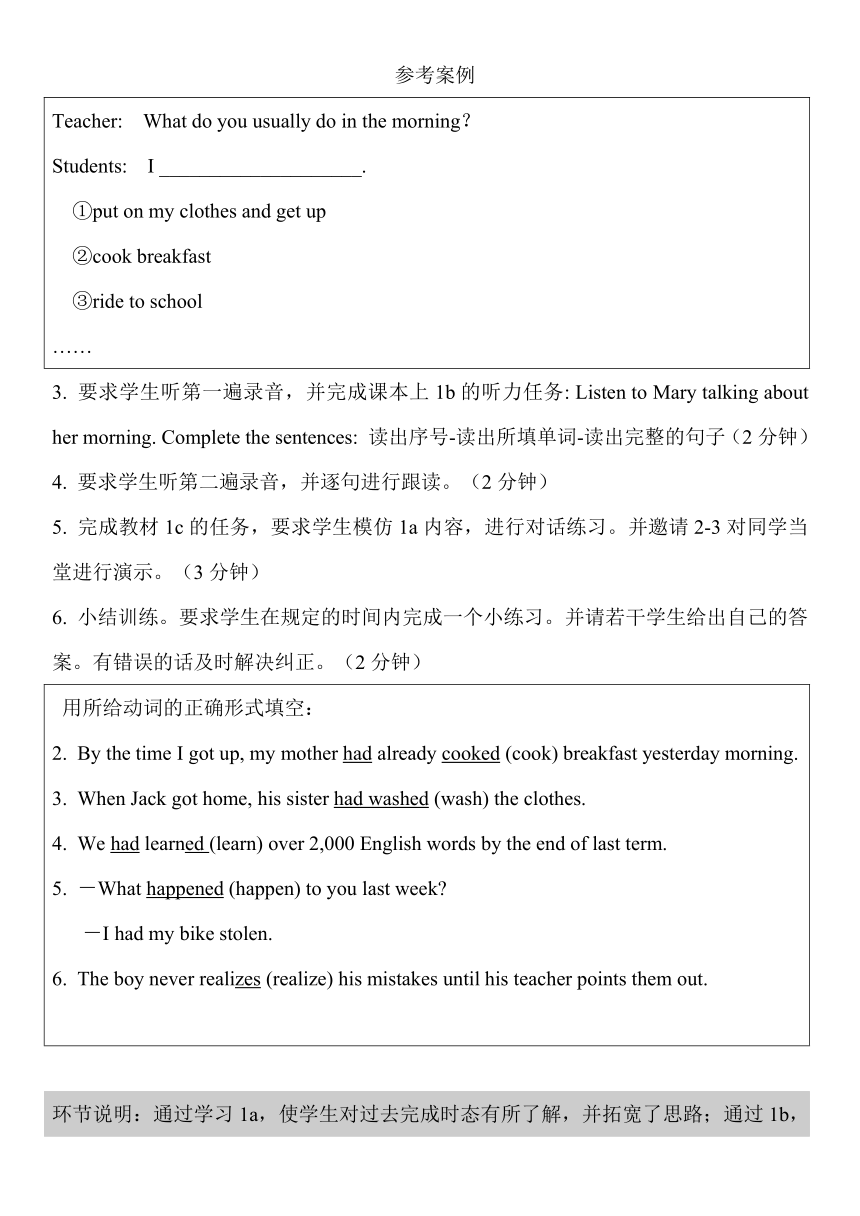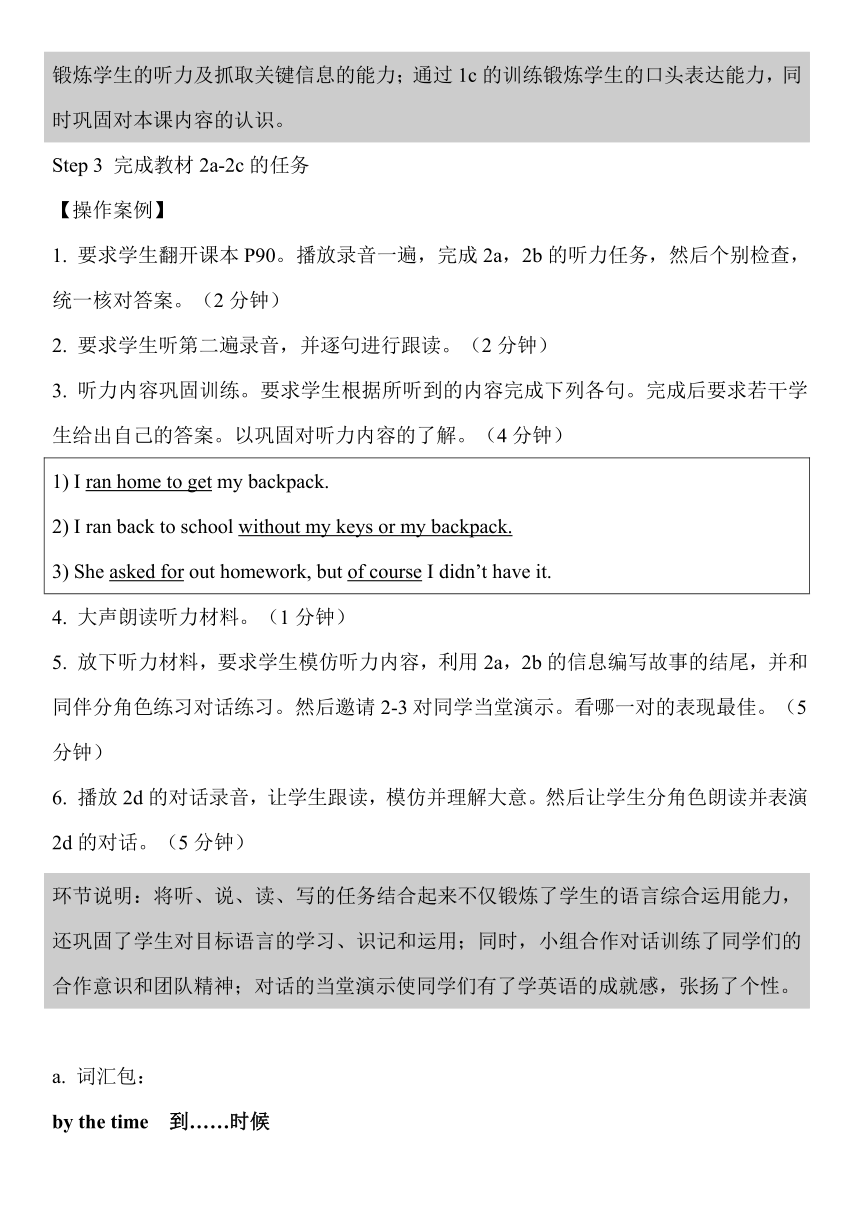九年级英语Unit 12 Life is full of the unexpected Section A 导学案(3课时,无答案)
文档属性
| 名称 | 九年级英语Unit 12 Life is full of the unexpected Section A 导学案(3课时,无答案) |  | |
| 格式 | zip | ||
| 文件大小 | 131.7KB | ||
| 资源类型 | 教案 | ||
| 版本资源 | 人教新目标(Go for it)版 | ||
| 科目 | 英语 | ||
| 更新时间 | 2017-02-13 14:58:24 | ||
图片预览





文档简介
Unit
12
Life
is
full
of
the
unexpected
Section
A
导学案
第一课时
Section
A(1a
~
2d)
I.
I.
知识目标
类别
课时要点
重点单词
1.backpack
n.
背包,旅行包;2.
oversleep
v.
睡过头
重点词组
1.
take
a
shower洗浴
2.
leave
my
backpack
at
home把背包忘在家里
3.
get
back
to
school返回学校
4.
start
teaching开始教学
5.
go
off响铃
6.
rush
out
the
door冲出房门
7.
give
sb
a
lift捎某人一程
重点句式
1.
By
the
time
I
got
up,
my
brother
had
already
gotten
in
the
shower.当我起床时,我哥哥已经进了浴室了。2.
By
the
time
I
got
outside,
the
bus
had
already
gone.当我出来时,公汽已经走了。3.
When
I
got
to
school,
I
realized
I
had
left
my
backpack
at
home.当我到达学校时,我才意识到我把背包忘在家里了。4.
By
the
time
I
walked
into
class,
the
teacher
had
started
teaching
already.当我走进教室时,老师已经开始讲课了。5.
I
didn’t
even
brush
my
teeth
or
wash
my
face.
我甚至没有刷牙也没有洗脸。
II.
课堂环节
§自主学习方案
【自学自查】
根据汉语提示完成单词。
1.
I
got
to
school
late
because
I
overslept(睡过头)this
morning.
2.
When
I
got
home,
I
realized
I
had
left
(遗忘)my
English
book
at
school.
3.
It’s
cold
outside
(在外面),
you’d
better
wear
more
clothes.
4.
When
I
got
to
school,
I
realized(意识到)I
forgot
to
bring
my
homework.
5.
You’d
better
put
your
homework
in
your
backpack
(背包).
§课堂导学方案
Step
1
情景导入(参考案例)
Teacher:
For
one
or
more
times
in
our
school
times
,we
are
late
for
school.
Have
you
ever
been
late
for
school
Can
you
tell
me
why
And
what
happened
to
you
that
day
Students:
___________
①
Yes,
I
have
been
late
for
school
one
times.
Because…
②
I
was
nearly
late
for
class
one
day
and
……
环节说明:通过课前的一个师生问答互动引入新课的话题
Step
2
完成教材1a-1c的任务
【操作案例】
1.
要求学生翻开课本P89,迅速阅读1a部分的内容。并按要求完成课本上相应的任务:
Look
at
the
pictures
what
happened
to
the
girl.(1分钟)
2.
检查答案,先要求全班一起给出答案并检查讨论。然后要求2-3名同学就What
do
you
usually
do
in
the
morning?给出自己的答案,并把收集的答案列举在黑板上。(3分钟)
参考案例
Teacher:
What
do
you
usually
do
in
the
morning?Students:
I
____________________.
①put
on
my
clothes
and
get
up②cook
breakfast③ride
to
school……
3.
要求学生听第一遍录音,并完成课本上1b的听力任务:
Listen
to
Mary
talking
about
her
morning.
Complete
the
sentences:
读出序号-读出所填单词-读出完整的句子(2分钟)
4.
要求学生听第二遍录音,并逐句进行跟读。(2分钟)
5.
完成教材1c的任务,要求学生模仿1a内容,进行对话练习。并邀请2-3对同学当堂进行演示。(3分钟)
6.
小结训练。要求学生在规定的时间内完成一个小练习。并请若干学生给出自己的答案。有错误的话及时解决纠正。(2分钟)
用所给动词的正确形式填空:By
the
time
I
got
up,
my
mother
had
already
cooked
(cook)
breakfast
yesterday
morning.When
Jack
got
home,
his
sister
had
washed
(wash)
the
clothes.We
had
learned
(learn)
over
2,000
English
words
by
the
end
of
last
term.
-What
happened
(happen)
to
you
last
week
-I
had
my
bike
stolen.The
boy
never
realizes
(realize)
his
mistakes
until
his
teacher
points
them
out.
环节说明:通过学习1a,使学生对过去完成时态有所了解,并拓宽了思路;通过1b,锻炼学生的听力及抓取关键信息的能力;通过1c的训练锻炼学生的口头表达能力,同时巩固对本课内容的认识。
Step
3
完成教材2a-2c的任务
【操作案例】
1.
要求学生翻开课本P90。播放录音一遍,完成2a,2b的听力任务,然后个别检查,统一核对答案。(2分钟)
2.
要求学生听第二遍录音,并逐句进行跟读。(2分钟)
3.
听力内容巩固训练。要求学生根据所听到的内容完成下列各句。完成后要求若干学生给出自己的答案。以巩固对听力内容的了解。(4分钟)
1)
I
ran
home
to
get
my
backpack.2)
I
ran
back
to
school
without
my
keys
or
my
backpack.3)
She
asked
for
out
homework,
but
of
course
I
didn’t
have
it.
4.
大声朗读听力材料。(1分钟)
5.
放下听力材料,要求学生模仿听力内容,利用2a,2b的信息编写故事的结尾,并和同伴分角色练习对话练习。然后邀请2-3对同学当堂演示。看哪一对的表现最佳。(5分钟)
6.
播放2d的对话录音,让学生跟读,模仿并理解大意。然后让学生分角色朗读并表演2d的对话。(5分钟)
环节说明:将听、说、读、写的任务结合起来不仅锻炼了学生的语言综合运用能力,还巩固了学生对目标语言的学习、识记和运用;同时,小组合作对话训练了同学们的合作意识和团队精神;对话的当堂演示使同学们有了学英语的成就感,张扬了个性。
a.
词汇包:
by
the
time
到……时候
【备课例句】
by
the
time作连词引导时间状语从句,当从句用一般过去时,主句用过去完成时;当从句用一般现在时,主句用一般将来时或将来完成时。
By
the
time
he
was
ten,
Tom
built
a
chemistry
lab
himself.
等到了十岁的时候,汤姆自己建了一个化学实验室。
I’ll
be
in
bed
by
the
time
you
get
home.
你到家时,我已经上床睡觉了。
【课堂变式】
—By
the
time
I
was
five,
I
____English.
—Really A.
had
started
learning
B.
have
started
learning
C.
started
to
learn
D.
started
learning
【解析】by
the
time所引导的从句是一般过去时,其主句要用过去完成时。正确答案是A。
b.
句式包:
1.By
the
time
I
got
outside,
the
bus
had
already
left.
当我出来的时候,公共汽车已经走了。
本句是by
the
time引导的时间状语从句,从句是I
got
up,是一般过去时。主句the
bus
had
already
left是过去完成时。过去完成时表示在过去某个时间之前已经发生的动作或一直延续的动作或状态。它表示的动作所发生的时间是“过去的过去”,常用“助动词had+过去分词”构成。常与过去完成时连用的时间状语有:by(the
end
of)+过去的时间,for+段时间,since+点时间,when引导的时间状语从句(从句中谓语动词用过去时)等。
【备课例句】
By
the
end
of
the
match,
they
had
kicked
two
goals
and
we
had
kicked
four.
到比赛结束时,他们已踢进两个球,我们进了四个球。”
By
the
time
she
got
up,
her
brother
had
already
gone
into
the
bathroom.
在她起床之前,她的弟弟已经进了盥洗室。
【横向辐射】过去完成时与现在完成时的区别
过去完成时与现在完成时的主要区别是时间的参照点不同:过去完成时的时间参照点是某个“过去的”时间;现在完成时的时间参照点是“现在”。因此现在完成时中的很多规则,也适用于过去完成时。【例句】When
I
got
to
the
cinema,
the
film
had
been
on
for
five
minutes.当我到达电影院时,电影已演了五分钟了。(got是一个过去的“时间点”,电影“开始”在我“到达”之前,是“过去的过去”。因为for
five
minutes为延续一段的时间状语,应用可延续的系表结构be
on的过去完成时形式。)【温馨提示】过去完成时是一个相对的时态,表示的是“过去的过去”,只有在和过去某时或某动作相比较时才用到它,因此当原句中若找不到一个“过去的时间”作为参照点时,是不能用过去完成时的。
【例句】He
got
to
the
railway
station
and
suddenly
realized
that
he
had
forgotten
to
bring
his
ticket.他到了火车站后忽然意识到他竟忘记带车票了。(“忘记”这一动作在“意识到”这一动作之前。)
【课堂变式】
1.—Why
didn’t
you
go
to
the
movie
yesterday —Because
I
____it
before.
A.
had
watched
B.
have
seen
C.
have
watched
D.
had
seen
【解析】“看电影”要用动词see,所以可先排除A和C。再由yesterday可知答话者在昨天之前就已看过这部电影,即“过去的过去”,要用过去完成时。正确答案是D。2.By
the
end
of
last
year,
we
____
about
2000
English
words.
A.
were
learning
B.
have
learnt
C.
learnt
D.
had
learnt
【解析】由时间状语By
the
end
of
last
year可知应用过去完成时,即“had+过去分词”。正确答案是D。3.
Since
2000,
Nanchang
has
become
a
new
city.
Everything
____.
A.
is
changed
B.
was
changed
C.
has
changed
D.
had
changed
【解析】由上文中的Since
2000可知过去的动作change对现在产生了结果,即一切发生了变化,应用现在完成时。正确答案是C。
2.
When
she
got
to
school,
she
realized
she
had
left
her
backpack
at
home.
当她到学校时,她意识到她把背包忘在家里了。
表示“把某物忘在某处”要用词组leave
sth
in
a
place。
【备课例句】
I've
left
my
umbrella
at
home.我把伞忘在家里了。
I
left
my
book
on
the
desk.
我把书忘在桌子上。
【横向辐射】forget
forget意为“遗忘某物”,指忘记一件具体的东西,但不能有具体的地点。【例句】I
forgot
my
umbrella
yesterday
.我昨天忘了带伞。Don't
forget
the
cases.
别忘了带箱子。
【课堂变式】
—Boys
and
girls!
Please
____
your
compositions
after
class.
—Oh,
my
God!
I
___
it
at
home.
A.
hand
in,
forgot
B.
hand
in,
left
C.
hand
out,
forgot
D.
hand
out,
left
【解析】hand
in意为“上交”,hand
out意为“分发”。可先排除C和D。forget意为“遗忘某物”,指忘记一件具体的东西,但不能有具体的地点。leave意为“遗忘某物在某处”,后应接具体的地点。由此根据at
home确定正确答案是B。
第二课时
Section
A(3a
~
3c)
I.
知识目标类别
课时要点
重点单词
1.
miss
v.
错过,未得到;
2.
unexpected
adj.
出乎意料的;3.
block
n.
街区
4.
worker
n.
工作者
5.
stare
v.
盯着看,凝视6.
disbelief
n.
不信,怀疑7.
above
adv.
在上面
8.
burn
v.
着火;燃烧;
9.alive
adj.
活着的;有生气的;10.
airport
n.
飞机场11.
till
conj.&
prep.
直到12.
west
adv.
向西
重点词组
1.
miss
both
events错过两个事件
2.
full
of
unexpected充满着不可预知性
3.
be
about
to
do
sth正要做某事
4.
stare
in
disbelief
at难以置信地盯着.
5.
raise
above
the
burning
building
从正在燃烧的楼上升起6.
jump
out
of
bed跳下床
重点句式
1.
I
was
about
to
go
up
when
I
decided
to
get
a
coffee
first.我正准备上去,我突然决定先喝一杯咖啡。2.
As
I
was
waiting
in
line
with
other
office
workers,
I
heard
a
loud
sound.
正当我和其他的员工在排队等候时,我听到了一声巨响。3.
Before
I
could
join
the
others
outside
to
see
what
were
going
on,
the
first
plane
had
already
hit
my
office
building.我还没来得及和其他人到外面看发生什么事,第一架飞机已经撞上了我办公室的楼房。4.
But
by
the
time
I
got
to
the
airport,
my
plane
to
New
Zealand
had
already
taken
off.但是当我到达飞机场时,我的飞往新西兰的飞机已经起飞了。5.
My
bad
luck
had
unexpectedly
turned
into
a
good
thing.我的坏运气出乎意料地变成了好事。
II.
课堂环节
§自主学习方案
【新词自查】
根据汉语提示完成单词。
1.
I
didn’t
call
him
up
because
I
wanted
to
give
him
an
unexpected(出乎意料的)
surprise.
2.
The
woman
stared
in
disbelief
(不信)
at
the
large
pile
of
money
on
the
table.
3.
Every
morning,
when
I
wake
up,
I
will
thanks
God
that
I
am
still
alive
(活着)。
4.
Two
hours
later,
the
fireman
got
to
the
burning(燃烧)house.
5.
After
Bert
got
up,
he
drove
to
the
airport(飞机场)
to
meet
Mr.
Black.
§课堂导学方案
Step
1情景导入(参考案例)
播放一段美国9.11恐怖袭击或日本大地震,菲律宾海啸的视频,
让同学回答这分别是什么事件,并询问他们在生活中是否碰到过一些意想不到的事。(4分钟)
环节说明:通过上述图片或影片的介绍,使学生对这两个短文有了一定的了解,从而达到导入新课的目的。引起学习短文的兴趣。
Step
2完成教材3a
的任务
1.
要求学生快速默读短文,熟知大意,并完成课本3a的任务。然后邀请几位同学给出自己的答案,全班一起检查讨论。(3分钟)
1.
one
is
The
9.11
terrorist
attacks
in
New
York
and
the
other
is
New
Zealand
big
earthquake.
2.
His
bad
luck
had
unexpectedly
turned
into
good
thing.
2.
先邀请几位同学朗读短文,教师要注意语音,及时纠正。然后播放录音,全班同学一起跟读。(3分钟)
3.
短文内容巩固练习。让学生用自己的话复述根短文内容。(4分钟)
4.
完成教材3b的任务,要求学生再次阅读短文,找出与3b的方框中所给单词意思相反的单词并用每个单词造一个句子。
(5分钟)
5.让学生以小组为单位,用3c所给词的提示复述其中的一个故事。
环节说明:将听、说、读、写的任务结合起来不仅锻炼了学生的语言综合运用能力,还巩固了学生对目标语言的学习、识记和运用。
a.
词汇包:
1.
above
adv.
在上面
above的用法
一、作介词
1.
在...上面
The
moon
is
now
above
the
trees.月亮正位于树梢上。
2.
在...之上,超过
They
are
children
above
six
years
old.他们是六岁以上的孩子。
3.
高于;优于;胜过
In
the
company,
Dick
ranks
above
Tom.在公司里,迪克的地位比汤姆高。
4.
不屑于;不致于
He
considered
himself
above
doing
such
things.
他自认为是不会去做那种事的。
二、作副词
在上面;向上面
There
are
snowy
peaks
above.上面是白雪皑皑的群峰。
2.
(级别、数目等)更高;更大;更多
Men
and
women
of
eighteen
and
above
are
eligible
to
vote.年龄在十八岁以上的男女有投票表决权。
3.
在上文
See
the
examples
given
above.见上述例子。
三、作名词
1.
上文;上述事实
In
addition
to
all
of
the
above,
she
won
a
Prize
in
1980.除上述外,她还在1980年获奖
( http: / / www.21cnjy.com"
\t
"_blank"
\o
"欢迎登陆21世纪教育网 )。
【备课例句】
The
plane
flew
above
the
clouds.
飞机在云层上飞行。
【横向辐射】above,on,
over的用法
1.
above的意思是“在…之上”,“高于…”,表示相对高度,不一定是在正上方,它的反义词是below.
例:The
plane
flew
above
the
clouds.飞机在云层上面飞行。
2.
over的意思是“在…之上”,表示在垂直之上,其反义词是under.
例:There
is
a
bridge
over
the
river.
河上有座桥。
There
is
a
boat
under
the
bridge.
桥下有一只船。
3.on的意思是“在…上面”,表示与表面接触。例:
He
put
the
book
on
the
desk.他把书放在课桌上。
【课堂变式】
Ice
is
not
often
seen
here
in
winter
as
the
temperature
normally
stays
zero.A.
up
B.
down
C.
above
D.
below【解析】本题考查介词词义辨析。up在……的上面;down在……的下面;above在上面;below在下面。句意为“这儿冬天很少看到冰,因为气温正常在零度以上。stay
above
zero在零度以上。故选C。
2.
alive
adj.
活着的;有生气的;
alive,
living
与live
1.
alive
主要用作表语(有时可用作后置定语,但不用作前置定语),可用于人或动物。如:He
must
be
still
alive.
他一定还活着。
注:若
alive
本身有修饰语,则也可用作前置定语。如:He
is
a
really
alive
student.
他的确是一个十分活跃的学生。
2.
living
可用作表语或定语,可用于人或物。如:
Are
your
grandparents
still
living?
你的祖父母还健在吗?
alive
和
living
表示“活着的”,两者含义很接近,只要句法适合,有时可互换。如:谁是当代最伟大的诗人?
正:Who
is
the
greatest
living
poet?
正:Who
is
the
greatest
poet
alive?
若需严格区分,两者仍有差别:living
通常是客观描述某人“尚在人间”或“健在”,而
alive
则主要指生与死的“界限”。如:He
was
still
alive
when
I
reached
the
hospital.
当我赶到医院时他还活着。
3.
live
通常只用作定语(前置),可用于动物或植物,但一般不用于人。如:
He
bought
some
live
fish.
他买了几条活鱼。
Only
a
few
live
trees
were
left
after
the
fire.
火灾之后只剩下几棵树还活着
【课堂变式】
Don’t
be
too
sad,
we
should
feel
lucky
to
be
_____(live).【解析】考查形容词,由句意可知。我们应当感到幸运我们活着,be
alive表示活着的状态。故填alive
第三课时Section
A(Grammar
focus
~
4c)
I.
知识目标
类别
课时要点
重点单词
1.
cream
n.
奶油,乳脂;
2.pie
n.
果馅饼;3.
bean
n.
豆荚;
4.
market
n.
集市;
重点词组
1.
collect
the
math
homework收数学作业
2.
complete
the
work
for
my
boss
完成老板的工作
3.
make
the
apple
pie制作苹果馅饼
4.
show
up赶到,出现
5.
add
the
green
beans添加绿豆荚
重点句式
1.
By
the
time
I
got
back
to
school,
the
bell
had
rung.当我返回学校时,上课铃已响了。2.
Before
I
got
to
the
bus
stop,
the
bus
had
already
left.在我到达公交站之前,公汽已离开了。3.
By
the
time
I
arrived
at
the
party,
everyone
else
had
already
showed
up.
当我到达晚会时,
其他的每个人都已经到了。4.
When
he
put
the
noodles
into
the
bowl,
he
realized
he
had
forgotten
to
add
the
green
beans.
当他把面条放进碗里时,他意识到他忘了添加绿豆荚了。5.
Before
she
got
a
chance
to
say
goodbye,
he
had
gone
into
the
building.在她得到一个向他告别的机会之前,他已经进入楼房了。
II.
课堂环节
§自主学习方案
【新词自查】
根据汉语提示完成单词。
1.
Dad,
I
am
going
to
be
late
for
school.
Can
you
give
me
a
lift
2.
My
alarm
clock
didn’t
ring
off
,
so
I
overslept
this
morning.
3.
Why
do
you
all
stare
me
in
disbelief
Don’t
you
believe
me
4.
This
fish
isn’t
dead
but
it
is
still
alive.
Look!
It
is
still
moving.
5.
I
would
tell
you
the
truth
unless
the
sun
raised
from
the
west.
§课堂导学方案
Step
1情景导入(参考案例)
Teacher:
It
seems
that
everyone
is
busy
in
the
morning.
We
never
have
enough
time
on
school
mornings.
(Show
a
flash
on
the
screen.
It
seems
more
lively
and
interesting.)
What
do
you
usually
do
in
the
morning
Students:
_____________________.
①
I
put
on
my
clothes
and
get
up.
②
I
brush
my
teeth
and
wash
my
face
and
so
on..
……
环节说明:通过课前的一个师生问答互动引入新课的话题
Step
2.
畅通Grammar
Focus回顾语法重点.
要求学生分角色问答并翻译表格中的句子。出说过去完成时的句型结构及基本用法。并能造出相仿的句子。
Step
3
完成教材4a-4b的任务
1.
要求学生翻开课本P92,参照例句用by
the
time或before造句。.给出5分钟的时限,然后请5位同学朗读句子,全班集体核对答案。(5分钟)
The
answers:
2.
Before
I
put
cream
in
the
coffee,
the
coffee
had
become
cold.
3.
By
the
time
I
got
to
school,
the
teacher
had
collected
the
math
homework.
4.
Before
the
workday
ended,
I
had
completed
the
work
for
my
boss.
5.
By
the
time
I
arrived
at
the
cinema,
the
movie
had
started.
6.
By
the
time
I
got
home
from
my
language
course,
my
mother
had
finished
making
the
apple
pie.
2.用4b方框中所给单词的正确形式填空完成句子,给出5分钟的时限,然后请6位同学朗读句子,全班集体核对答案。(5分钟)
1.
had,
showed
up
2.
had,
forgotten3.
had,
rushed
out
4.had,
forgotten
5.
arrived
at
6.
had
gone
into
4.根据你昨天的活动,写出两个正确的陈述和一个错误的陈述,然后让你的同伴猜出错误的陈述。(2分钟)
环节说明:将听、说、读、写的任务结合起来不仅锻炼了学生的语言综合运用能力,还巩固了学生对目标语言的学习、识记和运用。
12
Life
is
full
of
the
unexpected
Section
A
导学案
第一课时
Section
A(1a
~
2d)
I.
I.
知识目标
类别
课时要点
重点单词
1.backpack
n.
背包,旅行包;2.
oversleep
v.
睡过头
重点词组
1.
take
a
shower洗浴
2.
leave
my
backpack
at
home把背包忘在家里
3.
get
back
to
school返回学校
4.
start
teaching开始教学
5.
go
off响铃
6.
rush
out
the
door冲出房门
7.
give
sb
a
lift捎某人一程
重点句式
1.
By
the
time
I
got
up,
my
brother
had
already
gotten
in
the
shower.当我起床时,我哥哥已经进了浴室了。2.
By
the
time
I
got
outside,
the
bus
had
already
gone.当我出来时,公汽已经走了。3.
When
I
got
to
school,
I
realized
I
had
left
my
backpack
at
home.当我到达学校时,我才意识到我把背包忘在家里了。4.
By
the
time
I
walked
into
class,
the
teacher
had
started
teaching
already.当我走进教室时,老师已经开始讲课了。5.
I
didn’t
even
brush
my
teeth
or
wash
my
face.
我甚至没有刷牙也没有洗脸。
II.
课堂环节
§自主学习方案
【自学自查】
根据汉语提示完成单词。
1.
I
got
to
school
late
because
I
overslept(睡过头)this
morning.
2.
When
I
got
home,
I
realized
I
had
left
(遗忘)my
English
book
at
school.
3.
It’s
cold
outside
(在外面),
you’d
better
wear
more
clothes.
4.
When
I
got
to
school,
I
realized(意识到)I
forgot
to
bring
my
homework.
5.
You’d
better
put
your
homework
in
your
backpack
(背包).
§课堂导学方案
Step
1
情景导入(参考案例)
Teacher:
For
one
or
more
times
in
our
school
times
,we
are
late
for
school.
Have
you
ever
been
late
for
school
Can
you
tell
me
why
And
what
happened
to
you
that
day
Students:
___________
①
Yes,
I
have
been
late
for
school
one
times.
Because…
②
I
was
nearly
late
for
class
one
day
and
……
环节说明:通过课前的一个师生问答互动引入新课的话题
Step
2
完成教材1a-1c的任务
【操作案例】
1.
要求学生翻开课本P89,迅速阅读1a部分的内容。并按要求完成课本上相应的任务:
Look
at
the
pictures
what
happened
to
the
girl.(1分钟)
2.
检查答案,先要求全班一起给出答案并检查讨论。然后要求2-3名同学就What
do
you
usually
do
in
the
morning?给出自己的答案,并把收集的答案列举在黑板上。(3分钟)
参考案例
Teacher:
What
do
you
usually
do
in
the
morning?Students:
I
____________________.
①put
on
my
clothes
and
get
up②cook
breakfast③ride
to
school……
3.
要求学生听第一遍录音,并完成课本上1b的听力任务:
Listen
to
Mary
talking
about
her
morning.
Complete
the
sentences:
读出序号-读出所填单词-读出完整的句子(2分钟)
4.
要求学生听第二遍录音,并逐句进行跟读。(2分钟)
5.
完成教材1c的任务,要求学生模仿1a内容,进行对话练习。并邀请2-3对同学当堂进行演示。(3分钟)
6.
小结训练。要求学生在规定的时间内完成一个小练习。并请若干学生给出自己的答案。有错误的话及时解决纠正。(2分钟)
用所给动词的正确形式填空:By
the
time
I
got
up,
my
mother
had
already
cooked
(cook)
breakfast
yesterday
morning.When
Jack
got
home,
his
sister
had
washed
(wash)
the
clothes.We
had
learned
(learn)
over
2,000
English
words
by
the
end
of
last
term.
-What
happened
(happen)
to
you
last
week
-I
had
my
bike
stolen.The
boy
never
realizes
(realize)
his
mistakes
until
his
teacher
points
them
out.
环节说明:通过学习1a,使学生对过去完成时态有所了解,并拓宽了思路;通过1b,锻炼学生的听力及抓取关键信息的能力;通过1c的训练锻炼学生的口头表达能力,同时巩固对本课内容的认识。
Step
3
完成教材2a-2c的任务
【操作案例】
1.
要求学生翻开课本P90。播放录音一遍,完成2a,2b的听力任务,然后个别检查,统一核对答案。(2分钟)
2.
要求学生听第二遍录音,并逐句进行跟读。(2分钟)
3.
听力内容巩固训练。要求学生根据所听到的内容完成下列各句。完成后要求若干学生给出自己的答案。以巩固对听力内容的了解。(4分钟)
1)
I
ran
home
to
get
my
backpack.2)
I
ran
back
to
school
without
my
keys
or
my
backpack.3)
She
asked
for
out
homework,
but
of
course
I
didn’t
have
it.
4.
大声朗读听力材料。(1分钟)
5.
放下听力材料,要求学生模仿听力内容,利用2a,2b的信息编写故事的结尾,并和同伴分角色练习对话练习。然后邀请2-3对同学当堂演示。看哪一对的表现最佳。(5分钟)
6.
播放2d的对话录音,让学生跟读,模仿并理解大意。然后让学生分角色朗读并表演2d的对话。(5分钟)
环节说明:将听、说、读、写的任务结合起来不仅锻炼了学生的语言综合运用能力,还巩固了学生对目标语言的学习、识记和运用;同时,小组合作对话训练了同学们的合作意识和团队精神;对话的当堂演示使同学们有了学英语的成就感,张扬了个性。
a.
词汇包:
by
the
time
到……时候
【备课例句】
by
the
time作连词引导时间状语从句,当从句用一般过去时,主句用过去完成时;当从句用一般现在时,主句用一般将来时或将来完成时。
By
the
time
he
was
ten,
Tom
built
a
chemistry
lab
himself.
等到了十岁的时候,汤姆自己建了一个化学实验室。
I’ll
be
in
bed
by
the
time
you
get
home.
你到家时,我已经上床睡觉了。
【课堂变式】
—By
the
time
I
was
five,
I
____English.
—Really A.
had
started
learning
B.
have
started
learning
C.
started
to
learn
D.
started
learning
【解析】by
the
time所引导的从句是一般过去时,其主句要用过去完成时。正确答案是A。
b.
句式包:
1.By
the
time
I
got
outside,
the
bus
had
already
left.
当我出来的时候,公共汽车已经走了。
本句是by
the
time引导的时间状语从句,从句是I
got
up,是一般过去时。主句the
bus
had
already
left是过去完成时。过去完成时表示在过去某个时间之前已经发生的动作或一直延续的动作或状态。它表示的动作所发生的时间是“过去的过去”,常用“助动词had+过去分词”构成。常与过去完成时连用的时间状语有:by(the
end
of)+过去的时间,for+段时间,since+点时间,when引导的时间状语从句(从句中谓语动词用过去时)等。
【备课例句】
By
the
end
of
the
match,
they
had
kicked
two
goals
and
we
had
kicked
four.
到比赛结束时,他们已踢进两个球,我们进了四个球。”
By
the
time
she
got
up,
her
brother
had
already
gone
into
the
bathroom.
在她起床之前,她的弟弟已经进了盥洗室。
【横向辐射】过去完成时与现在完成时的区别
过去完成时与现在完成时的主要区别是时间的参照点不同:过去完成时的时间参照点是某个“过去的”时间;现在完成时的时间参照点是“现在”。因此现在完成时中的很多规则,也适用于过去完成时。【例句】When
I
got
to
the
cinema,
the
film
had
been
on
for
five
minutes.当我到达电影院时,电影已演了五分钟了。(got是一个过去的“时间点”,电影“开始”在我“到达”之前,是“过去的过去”。因为for
five
minutes为延续一段的时间状语,应用可延续的系表结构be
on的过去完成时形式。)【温馨提示】过去完成时是一个相对的时态,表示的是“过去的过去”,只有在和过去某时或某动作相比较时才用到它,因此当原句中若找不到一个“过去的时间”作为参照点时,是不能用过去完成时的。
【例句】He
got
to
the
railway
station
and
suddenly
realized
that
he
had
forgotten
to
bring
his
ticket.他到了火车站后忽然意识到他竟忘记带车票了。(“忘记”这一动作在“意识到”这一动作之前。)
【课堂变式】
1.—Why
didn’t
you
go
to
the
movie
yesterday —Because
I
____it
before.
A.
had
watched
B.
have
seen
C.
have
watched
D.
had
seen
【解析】“看电影”要用动词see,所以可先排除A和C。再由yesterday可知答话者在昨天之前就已看过这部电影,即“过去的过去”,要用过去完成时。正确答案是D。2.By
the
end
of
last
year,
we
____
about
2000
English
words.
A.
were
learning
B.
have
learnt
C.
learnt
D.
had
learnt
【解析】由时间状语By
the
end
of
last
year可知应用过去完成时,即“had+过去分词”。正确答案是D。3.
Since
2000,
Nanchang
has
become
a
new
city.
Everything
____.
A.
is
changed
B.
was
changed
C.
has
changed
D.
had
changed
【解析】由上文中的Since
2000可知过去的动作change对现在产生了结果,即一切发生了变化,应用现在完成时。正确答案是C。
2.
When
she
got
to
school,
she
realized
she
had
left
her
backpack
at
home.
当她到学校时,她意识到她把背包忘在家里了。
表示“把某物忘在某处”要用词组leave
sth
in
a
place。
【备课例句】
I've
left
my
umbrella
at
home.我把伞忘在家里了。
I
left
my
book
on
the
desk.
我把书忘在桌子上。
【横向辐射】forget
forget意为“遗忘某物”,指忘记一件具体的东西,但不能有具体的地点。【例句】I
forgot
my
umbrella
yesterday
.我昨天忘了带伞。Don't
forget
the
cases.
别忘了带箱子。
【课堂变式】
—Boys
and
girls!
Please
____
your
compositions
after
class.
—Oh,
my
God!
I
___
it
at
home.
A.
hand
in,
forgot
B.
hand
in,
left
C.
hand
out,
forgot
D.
hand
out,
left
【解析】hand
in意为“上交”,hand
out意为“分发”。可先排除C和D。forget意为“遗忘某物”,指忘记一件具体的东西,但不能有具体的地点。leave意为“遗忘某物在某处”,后应接具体的地点。由此根据at
home确定正确答案是B。
第二课时
Section
A(3a
~
3c)
I.
知识目标类别
课时要点
重点单词
1.
miss
v.
错过,未得到;
2.
unexpected
adj.
出乎意料的;3.
block
n.
街区
4.
worker
n.
工作者
5.
stare
v.
盯着看,凝视6.
disbelief
n.
不信,怀疑7.
above
adv.
在上面
8.
burn
v.
着火;燃烧;
9.alive
adj.
活着的;有生气的;10.
airport
n.
飞机场11.
till
conj.&
prep.
直到12.
west
adv.
向西
重点词组
1.
miss
both
events错过两个事件
2.
full
of
unexpected充满着不可预知性
3.
be
about
to
do
sth正要做某事
4.
stare
in
disbelief
at难以置信地盯着.
5.
raise
above
the
burning
building
从正在燃烧的楼上升起6.
jump
out
of
bed跳下床
重点句式
1.
I
was
about
to
go
up
when
I
decided
to
get
a
coffee
first.我正准备上去,我突然决定先喝一杯咖啡。2.
As
I
was
waiting
in
line
with
other
office
workers,
I
heard
a
loud
sound.
正当我和其他的员工在排队等候时,我听到了一声巨响。3.
Before
I
could
join
the
others
outside
to
see
what
were
going
on,
the
first
plane
had
already
hit
my
office
building.我还没来得及和其他人到外面看发生什么事,第一架飞机已经撞上了我办公室的楼房。4.
But
by
the
time
I
got
to
the
airport,
my
plane
to
New
Zealand
had
already
taken
off.但是当我到达飞机场时,我的飞往新西兰的飞机已经起飞了。5.
My
bad
luck
had
unexpectedly
turned
into
a
good
thing.我的坏运气出乎意料地变成了好事。
II.
课堂环节
§自主学习方案
【新词自查】
根据汉语提示完成单词。
1.
I
didn’t
call
him
up
because
I
wanted
to
give
him
an
unexpected(出乎意料的)
surprise.
2.
The
woman
stared
in
disbelief
(不信)
at
the
large
pile
of
money
on
the
table.
3.
Every
morning,
when
I
wake
up,
I
will
thanks
God
that
I
am
still
alive
(活着)。
4.
Two
hours
later,
the
fireman
got
to
the
burning(燃烧)house.
5.
After
Bert
got
up,
he
drove
to
the
airport(飞机场)
to
meet
Mr.
Black.
§课堂导学方案
Step
1情景导入(参考案例)
播放一段美国9.11恐怖袭击或日本大地震,菲律宾海啸的视频,
让同学回答这分别是什么事件,并询问他们在生活中是否碰到过一些意想不到的事。(4分钟)
环节说明:通过上述图片或影片的介绍,使学生对这两个短文有了一定的了解,从而达到导入新课的目的。引起学习短文的兴趣。
Step
2完成教材3a
的任务
1.
要求学生快速默读短文,熟知大意,并完成课本3a的任务。然后邀请几位同学给出自己的答案,全班一起检查讨论。(3分钟)
1.
one
is
The
9.11
terrorist
attacks
in
New
York
and
the
other
is
New
Zealand
big
earthquake.
2.
His
bad
luck
had
unexpectedly
turned
into
good
thing.
2.
先邀请几位同学朗读短文,教师要注意语音,及时纠正。然后播放录音,全班同学一起跟读。(3分钟)
3.
短文内容巩固练习。让学生用自己的话复述根短文内容。(4分钟)
4.
完成教材3b的任务,要求学生再次阅读短文,找出与3b的方框中所给单词意思相反的单词并用每个单词造一个句子。
(5分钟)
5.让学生以小组为单位,用3c所给词的提示复述其中的一个故事。
环节说明:将听、说、读、写的任务结合起来不仅锻炼了学生的语言综合运用能力,还巩固了学生对目标语言的学习、识记和运用。
a.
词汇包:
1.
above
adv.
在上面
above的用法
一、作介词
1.
在...上面
The
moon
is
now
above
the
trees.月亮正位于树梢上。
2.
在...之上,超过
They
are
children
above
six
years
old.他们是六岁以上的孩子。
3.
高于;优于;胜过
In
the
company,
Dick
ranks
above
Tom.在公司里,迪克的地位比汤姆高。
4.
不屑于;不致于
He
considered
himself
above
doing
such
things.
他自认为是不会去做那种事的。
二、作副词
在上面;向上面
There
are
snowy
peaks
above.上面是白雪皑皑的群峰。
2.
(级别、数目等)更高;更大;更多
Men
and
women
of
eighteen
and
above
are
eligible
to
vote.年龄在十八岁以上的男女有投票表决权。
3.
在上文
See
the
examples
given
above.见上述例子。
三、作名词
1.
上文;上述事实
In
addition
to
all
of
the
above,
she
won
a
Prize
in
1980.除上述外,她还在1980年获奖
( http: / / www.21cnjy.com"
\t
"_blank"
\o
"欢迎登陆21世纪教育网 )。
【备课例句】
The
plane
flew
above
the
clouds.
飞机在云层上飞行。
【横向辐射】above,on,
over的用法
1.
above的意思是“在…之上”,“高于…”,表示相对高度,不一定是在正上方,它的反义词是below.
例:The
plane
flew
above
the
clouds.飞机在云层上面飞行。
2.
over的意思是“在…之上”,表示在垂直之上,其反义词是under.
例:There
is
a
bridge
over
the
river.
河上有座桥。
There
is
a
boat
under
the
bridge.
桥下有一只船。
3.on的意思是“在…上面”,表示与表面接触。例:
He
put
the
book
on
the
desk.他把书放在课桌上。
【课堂变式】
Ice
is
not
often
seen
here
in
winter
as
the
temperature
normally
stays
zero.A.
up
B.
down
C.
above
D.
below【解析】本题考查介词词义辨析。up在……的上面;down在……的下面;above在上面;below在下面。句意为“这儿冬天很少看到冰,因为气温正常在零度以上。stay
above
zero在零度以上。故选C。
2.
alive
adj.
活着的;有生气的;
alive,
living
与live
1.
alive
主要用作表语(有时可用作后置定语,但不用作前置定语),可用于人或动物。如:He
must
be
still
alive.
他一定还活着。
注:若
alive
本身有修饰语,则也可用作前置定语。如:He
is
a
really
alive
student.
他的确是一个十分活跃的学生。
2.
living
可用作表语或定语,可用于人或物。如:
Are
your
grandparents
still
living?
你的祖父母还健在吗?
alive
和
living
表示“活着的”,两者含义很接近,只要句法适合,有时可互换。如:谁是当代最伟大的诗人?
正:Who
is
the
greatest
living
poet?
正:Who
is
the
greatest
poet
alive?
若需严格区分,两者仍有差别:living
通常是客观描述某人“尚在人间”或“健在”,而
alive
则主要指生与死的“界限”。如:He
was
still
alive
when
I
reached
the
hospital.
当我赶到医院时他还活着。
3.
live
通常只用作定语(前置),可用于动物或植物,但一般不用于人。如:
He
bought
some
live
fish.
他买了几条活鱼。
Only
a
few
live
trees
were
left
after
the
fire.
火灾之后只剩下几棵树还活着
【课堂变式】
Don’t
be
too
sad,
we
should
feel
lucky
to
be
_____(live).【解析】考查形容词,由句意可知。我们应当感到幸运我们活着,be
alive表示活着的状态。故填alive
第三课时Section
A(Grammar
focus
~
4c)
I.
知识目标
类别
课时要点
重点单词
1.
cream
n.
奶油,乳脂;
2.pie
n.
果馅饼;3.
bean
n.
豆荚;
4.
market
n.
集市;
重点词组
1.
collect
the
math
homework收数学作业
2.
complete
the
work
for
my
boss
完成老板的工作
3.
make
the
apple
pie制作苹果馅饼
4.
show
up赶到,出现
5.
add
the
green
beans添加绿豆荚
重点句式
1.
By
the
time
I
got
back
to
school,
the
bell
had
rung.当我返回学校时,上课铃已响了。2.
Before
I
got
to
the
bus
stop,
the
bus
had
already
left.在我到达公交站之前,公汽已离开了。3.
By
the
time
I
arrived
at
the
party,
everyone
else
had
already
showed
up.
当我到达晚会时,
其他的每个人都已经到了。4.
When
he
put
the
noodles
into
the
bowl,
he
realized
he
had
forgotten
to
add
the
green
beans.
当他把面条放进碗里时,他意识到他忘了添加绿豆荚了。5.
Before
she
got
a
chance
to
say
goodbye,
he
had
gone
into
the
building.在她得到一个向他告别的机会之前,他已经进入楼房了。
II.
课堂环节
§自主学习方案
【新词自查】
根据汉语提示完成单词。
1.
Dad,
I
am
going
to
be
late
for
school.
Can
you
give
me
a
lift
2.
My
alarm
clock
didn’t
ring
off
,
so
I
overslept
this
morning.
3.
Why
do
you
all
stare
me
in
disbelief
Don’t
you
believe
me
4.
This
fish
isn’t
dead
but
it
is
still
alive.
Look!
It
is
still
moving.
5.
I
would
tell
you
the
truth
unless
the
sun
raised
from
the
west.
§课堂导学方案
Step
1情景导入(参考案例)
Teacher:
It
seems
that
everyone
is
busy
in
the
morning.
We
never
have
enough
time
on
school
mornings.
(Show
a
flash
on
the
screen.
It
seems
more
lively
and
interesting.)
What
do
you
usually
do
in
the
morning
Students:
_____________________.
①
I
put
on
my
clothes
and
get
up.
②
I
brush
my
teeth
and
wash
my
face
and
so
on..
……
环节说明:通过课前的一个师生问答互动引入新课的话题
Step
2.
畅通Grammar
Focus回顾语法重点.
要求学生分角色问答并翻译表格中的句子。出说过去完成时的句型结构及基本用法。并能造出相仿的句子。
Step
3
完成教材4a-4b的任务
1.
要求学生翻开课本P92,参照例句用by
the
time或before造句。.给出5分钟的时限,然后请5位同学朗读句子,全班集体核对答案。(5分钟)
The
answers:
2.
Before
I
put
cream
in
the
coffee,
the
coffee
had
become
cold.
3.
By
the
time
I
got
to
school,
the
teacher
had
collected
the
math
homework.
4.
Before
the
workday
ended,
I
had
completed
the
work
for
my
boss.
5.
By
the
time
I
arrived
at
the
cinema,
the
movie
had
started.
6.
By
the
time
I
got
home
from
my
language
course,
my
mother
had
finished
making
the
apple
pie.
2.用4b方框中所给单词的正确形式填空完成句子,给出5分钟的时限,然后请6位同学朗读句子,全班集体核对答案。(5分钟)
1.
had,
showed
up
2.
had,
forgotten3.
had,
rushed
out
4.had,
forgotten
5.
arrived
at
6.
had
gone
into
4.根据你昨天的活动,写出两个正确的陈述和一个错误的陈述,然后让你的同伴猜出错误的陈述。(2分钟)
环节说明:将听、说、读、写的任务结合起来不仅锻炼了学生的语言综合运用能力,还巩固了学生对目标语言的学习、识记和运用。
同课章节目录
- Unit 1 How can we become good learners.
- Section A
- Section B
- Unit 2 I think that mooncakes are delicious!
- Section A
- Section B
- Unit 3 Could you please tell me where the restroom
- Section A
- Section B
- Unit 4 I used to be afraid of the dark.
- Section A
- Section B
- Unit 5 What are the shirts made of?
- Section A
- Section B
- Review of Units 1-5
- Unit 6 When was it invented?
- Section A
- Section B
- Unit 7 Teenagers should be allowed to choose their
- Section A
- Section B
- Unit 8 It must belong to Carla.
- Section A
- Section B
- Unit 9 I like music that I can dance to.
- Section A
- Section B
- Unit 10 You're supposed to shake hands.
- Section A
- Section B
- Review of Units 6-10
- Unit 11 Sad movies make me cry.
- Section A
- Section B
- Unit 12 Life is full of the unexpected
- Section A
- Section B
- Unit 13 We're trying to save the earth!
- Section A
- Section B
- Unit 14 I remember meeting all of you in Grade 7.
- Section A
- Section B
- Review of Units 11-14
